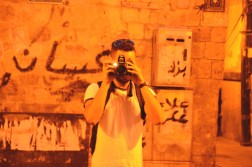
The quest to take better travel photos is lifelong, if only because you don’t want your current “best” travel photo to be your best ever.
When I took my infamous dog-and-butterfly photo “Lightning Strikes Once” in Laos a couple years ago, I was frightened of this very thing happening. I gave it this title because let’s be honest, how often does this:

“Lightning Strikes Once,” Laos, 2010
happen?
This article isn’t going to speak much to technical aspects of photography, but rather the sorts of photos that in my opinion make for great travel mementos. Taking better travel photos isn’t about having the “right” camera or shooting settings, but about capturing moments that transport anyone who seems them to the other side of the planet.

“The Eyes Have It,” China, 2010
Photographing People and Animals
When I first started taking travel photos, my immediate interest was in portraying people, whether that meant portraits of young children eager to pose for the camera or candid shots of locals living their lives. Being able to depict the people who call a certain city or country home is essential is capturing its essence for your audience, no matter its scope.
Photographing people brings up an interesting ethical dilemma. Specifically, do you ask permission or not? Although I would like to believe the answer to this question is a simple “Yes,” the fact is that people who are aware they’re being photographed almost always pose and while posed photography is great, it isn’t necessarily an accurate reflection of who the person is in relation to where they live. Go with your gut — mine usually tells me to snap the photo as fast as I can without being noticed.

“Chat Session,” Peru, 2011
With animals, this is less of a concern, as even their “poses” are overflowing with character and spontaneity. If you aren’t comfortable photographing people but still want to give your photos a “living” quality, photographing animals is a great way to go about it.

“Blowing Kisses in the Wind,” Spain, 2011
Depicting Place
Of course, people and animals aren’t the only things that exist in a particular destination, although they are important. If you want to take great travel photos, it’s essential to practice capturing the essence of a place itself.
I personally find it easier to do this in cities than it is in natural settings, if only because cities provide you with more familiar reference points. When I was touring southwest Bolivia last year, I found myself overwhelmed by the number of things going around me, from flamingos, to rock formations, to salt flats, to strangely-colored lakes and so on. I usually take more than double the amount of photos in nature than I would in the city, if only because it’s much more trial and error for me.

“Carbon-made,” Bolivia, 2011
In cities I focus on the usual things such as buildings, streets, parks and traffic, but focus on drawing out what is unique about a particular element of a city, what I believe sets it apart, rather than simply photographing something cool or interesting. A great way to do this is to get local artwork or foreign language in the picture, although that’s definitely not a hard and fast rule.

“Nighttime Refreshment,” Morocco, 2011
Food and Inanimate Objects
Another great way to give people who view your pictures and insight into what it was like being somewhere is to photograph inanimate objects. Food in particular helps achieve this because of the sensory associations people have with food. The more you can make someone taste the food you’re eating, the better.

“The One Who is Holy Loves You Truly,” Israel, 2011
How you go about photographing inanimate objects is up to you, but I usually try to portray them in a direct way — either straight on or from the top. Although elaborate framing and compositional techniques benefit people and place shots, I find that trying to get too fancy can detract attention from small and seemingly insignificant objects like food and other inanimate objects.
Perspective and Context
I touched on perspective and context in a more esoteric sense in another recent piece, but they are equally essential to consider in a tangible context. Simply put, how you portray a scene — be it a person, place or thing — can be the difference between a picture that is mind-blowing and a picture that is forgettable.
To illustrate the impact perspective can have, consider these two shots from my trip to Egypt this past September:

“Untitled,” Egypt, 2011

“Lakefarers,” Egypt, 2011
Notice how the second shot calls attention to the large number of boats contained in such a small area, while the first shot depicts such a large area that you hardly notice the boats?
Context, too, is important. After all, if a picture doesn’t at least somewhat give you a sense of where it was taken, how is it supposed to transport someone.
One way in which context can come in handy is as a tool for making cliche, ordinary shots interesting. Consider, for example, this shot of the Cristo Redento in Rio de Janeiro, Brazil, which is probably the most visited tourist attraction in all Brazil:

“With Arms Wide Open,” Brazil, 2011
Notice how my emphasis on the tourists and the statue give a commentary the scene at the statue’s base?
The same can be said for this shot of a motorbike in Vietnam, a photography subject that is far from unique for visitors to that country:

“Free and Clear,” Vietnam, 2010
I hope these travel photography tips have been helpful and beneficial to you. Do you have any of your own travel photography tips to offer? Please leave them in a comment if you do.

Robert Schrader is a travel writer and photographer who’s been roaming the world independently since 2005, writing for publications such as “CNNGo” and “Shanghaiist” along the way. His blog, Leave Your Daily Hell, provides a mix of travel advice, destination guides and personal essays covering the more esoteric aspects of life as a traveler.








